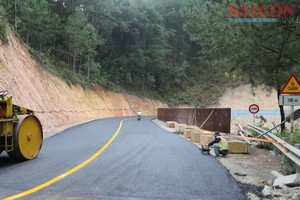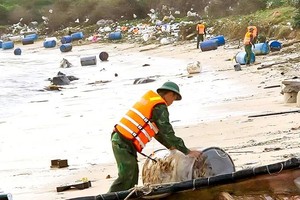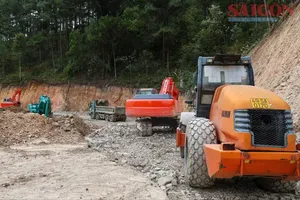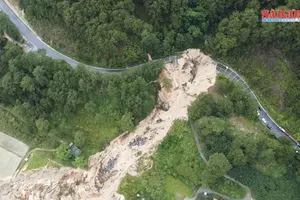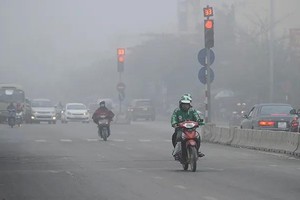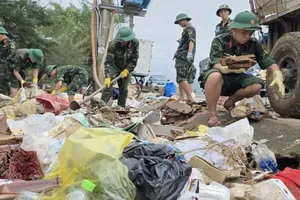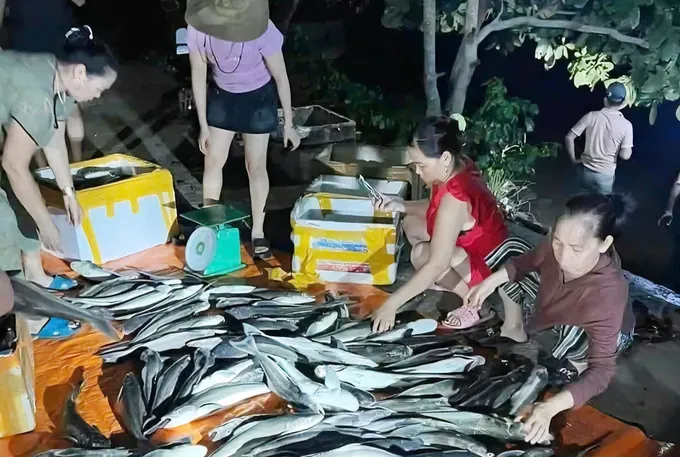
Never before have aquaculture farmers in the Central region experienced losses of such a catastrophic magnitude.
Vinh Son Commune in Vinh Linh District of Quang Tri Province, widely regarded as the region’s shrimp farming “capital” with its 171 hectares of ponds, is now nothing but an expansive, watery expanse.
Standing amidst a crowd of stunned onlookers gazing towards the Ben Hai River near the estuary, Tran Van Thuy, the owner of two shrimp ponds in Phan Hien Hamlet, could only watch in utter helplessness as his remaining shrimp, now the size of a thumb, suffocated and floated to the surface.
“Beginning in December 2024, my family stocked our two hectares of ponds with over twenty thousand shrimp post-larvae”, Thuy recounted. “The investment in post-larvae, feed, and labor amounted to nearly VND200 million (US$8,000). We anticipated harvesting and selling approximately two tons of shrimp by mid-June, which would have yielded a revenue of VND500 million ($20,000). Yet, in a single night, the storm and subsequent floods swept everything away.”
Tran Van Linh, another aquaculture farmer in Vinh Son Commune, anguishedly said that this devastation is not confined to their commune; the vast majority of aquaculture farmers across the provinces of Quang Binh, Quang Tri, and Hue City were left empty-handed by the unprecedented deluge.
“Losses ranged from one or two hundred million VND for some, to as high as a billion VND for others”, he explained. “Upon hearing the storm warning on the radio, my wife and I hurried to purchase stakes and netting to secure our ponds. However, by approximately 1:00 a.m. on June 13, the floodwaters surged so rapidly, rising over two meters, that they swept away both the protective nets and the shrimp. The surviving shrimp went into shock from the sudden change in water conditions and the fierce currents, ultimately perishing by the following day.”
Further upstream along the Hieu River, aquaculture farmers are making desperate efforts to salvage what they can, collecting dead fish to be sold at a fraction of their value or repurposed as animal feed. Many are completely crushed, having lost their entire livelihood overnight.
Vice Chairwoman Hoang Thi Thu Thuy of the People’s Committee of Cua Viet Town in Gio Linh District of Quang Tri Province reported that there are 10 households engaged in cage aquaculture on the Hieu River, managing a total of 30 cages. Their stocks, numbering approximately 32,000 fish including cobia, peacock bass, and croaker, have all perished, suffocated by the influx of floodwater from upstream.
The fish cage aquaculture area, situated near the high-salinity estuary, was overwhelmed by the deluge of freshwater, causing a drastic and sudden drop in salinity that resulted in mass mortality. Initial damage estimates for the fish farms are around VND1.8 billion ($72,000). Furthermore, Cua Viet Town has an additional 13 hectares of shrimp farms that were submerged, with losses estimated at VND1.2 billion ($48,000).
On June 15, capitalizing on a break in the weather and sunny skies, residents and local authorities in Quang Tri Province and Hue City have been urgently implementing measures to drain the floodwaters and salvage the recently sown summer-autumn rice crop, which was inundated by the flooding from Storm No.1. The affected areas total 21,211 hectares in Quang Tri Province and 22,418 hectares in Hue City.
According to Chief Dang Van Hoa of the Office for the Steering Committee for Natural Disaster Prevention, Control, and Search and Rescue of Hue City, in addition to 120 electric pumping stations, the city has also mobilized an additional 507 diesel-powered pumps, which are operating around the clock to drain the summer-autumn rice fields. Initial assessments indicate a possibility that between 5,000 and 10,000 hectares of rice paddies will need to be completely re-sown.
On the same day, the Hue City Department of Agriculture and Environment stated that the locality maintains a reserve of approximately 1,000 tonnes of rice seeds. These reserves are held at Plant and Animal Breeding JSC. and in the national reserve warehouse, ready to support the rehabilitation of damaged rice fields that cannot be salvaged. Should the area requiring reseeding reach 10,000 hectares, the current seed stock is deemed sufficient to meet the demand across the entire affected region.
Preliminary data compiled by the Offices of the Steering Committees for Natural Disaster Prevention, Control, and Search and Rescue for the provinces of Quang Binh, Quang Tri, and Hue City, indicate that the flooding from June 12-13 devastated approximately 2,000 hectares of brackish water aquaculture farms. In addition, hundreds of hectares of freshwater ponds and fish cages also saw their stocks either perish or be swept away by the floodwaters.

